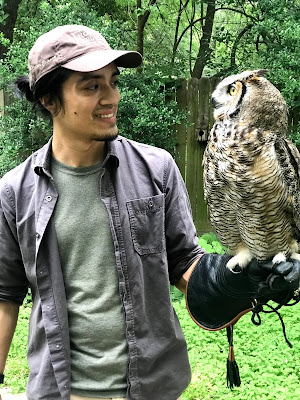Javier answered a few questions for us so everyone can get to know him a little better.
1. What’s your job title?
I am the new Environmental Educator and Staff Naturalist for Houston Audubon. I am excited to be a part of the team!
2. What sort of duties do you have at work?
I work primarily at the Houston Audubon Raptor Center and assist with the animal care, education programs, and general maintenance.
3. What’s the most exciting part of your job?
What is most exciting to me is that the Houston Audubon Raptor Center just opened to the public in 2019. I see a lot of potential for growth and public outreach, and I am looking forward to being a part of that process.
Working with the raptors and being able to teach people about them is also one of my favorite parts of the job. Honestly, there is nothing else quite like interacting with a bird of prey and gaining their trust.
4. Where did you work before this position?
Before coming to Houston Audubon, I was a Seasonal Naturalist with Lake Houston Wilderness Park. I was very fortunate to have work in my field during the pandemic. Before the pandemic, I had worked two jobs in Alaska, as an Avian Handler with the Alaska Raptor Center and a Tour Guide with the Alaska Rainforest Sanctuary.
5. What animal do you connect with the most?
Definitely a raven! What I admire most is their adaptability, cleverness, and instinctive curiosity. In many cultures and mythologies, ravens are revered for their intelligence and are even said to be the messengers of gods. How neat is that?
6. Are you a coffee or tea person?
Coffee, coffee, coffee.
7. Are you a morning person or a night owl?
Definitely a night owl…this may also explain my preference for coffee.
8. Do you have any hidden talents or hobbies?
I have a small art business that I hope to expand into something greater very soon. Color pencils are my favorite media, but I also do digital art, ink, watercolors, and even wood carving!
9. What is your favorite memory?
My biggest personal goal is to become a licensed falconer. Traveling for seasonal work made that goal impossible, but now that is something I am hoping to start as early as 2022.
Please join us in welcoming Javier to the Houston Audubon family. We hope you'll have the chance to meet him at an upcoming program!



Comments
Post a Comment